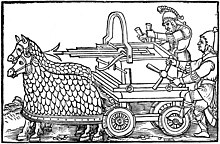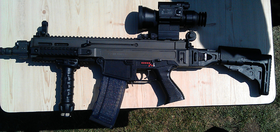 | |
| Abbreviation | TMG |
|---|---|
| Formation | January 1, 2015 |
| Founder | Abigail Harrison "Astronaut Abby" |
| Type | NGO Nonprofit corporation 501(c)(3) |
| Legal status | The Mars Generation is a "public charity" and is eligible to receive tax-deductible charitable contributions |
| Purpose | STEM education and space advocacy for human mission to Mars |
| Headquarters | Minneapolis, Minnesota, United States |
Key people
| Board of Directors:
|
| Website | themarsgeneration |
The Mars Generation is an American internationally active, non-governmental nonprofit organization involved in public outreach and advocating for human space exploration and science, technology, engineering, and mathematics (STEM) education.
The mission of The Mars Generation is to educate and inspire people of all ages about science, technology, engineering, and mathematics (STEM) and human space exploration and the importance of space and STEM to the future of humankind. The Mars Generation is volunteer-driven by executive and advisory boards with leaders from the space industry including astronauts, engineers and scientists as well as nonprofit, education and business sectors.since its founding in 2015.
In June 2017, The Mars Generation was recognized with a business innovation award for their use of technology to build the organization and its programs. This unique approach to creating a nonprofit is credited to the organization's founder and leader Abigail Harrison leveraging her own internet personality as Astronaut Abby to grow the organization. As of August 2017, The Mars Generation and Astronaut Abby have over one million followers of their combined social media channels and have reached an estimated 25 million.
History
The Mars Generation was founded in 2015 by 18-year-old Abigail Harrison,
popularly known as "Astronaut Abby" and has the support of high-level
advisory board members which includes astronauts, engineers and
scientists as well as nonprofit, education and business professionals.
Harrison started STEM and space advocacy work at the age of 13 by initially setting up a Twitter account under her childhood nickname "Astronaut Abby." She used her @AstronautAbby Twitter account to connect with NASA employees to try and procure a quote for her National History Day project.
Her account biography stated that she was aspiring to be an astronaut
and had a goal to be the first person to set foot on Mars. After she
received the NASA quote, she began to share her journey to Mars which
included tweets about space events, school and her personal life with
the goal of not only exciting people about mars exploration but creating
advocates for human space exploration.
In May 2013, at 15-years old, Harrison partnered with her mentor, Astronaut Luca Parmitano as his Earth Liaison and shared his experience living in space on the International Space Station during Expedition 36 and Expedition 37. Harrison setup an international outreach program consisting of classroom web chats, an email pen pal program, classroom visits, blogging on AstronautAbby.com, writing for other publications, speaking at events, and sharing on social media. Initially called the Soyuz Adventure, after Astronaut Parmitano returned to Earth, it was renamed "The Future of Space" and Harrison continued to run the program. This program was the basis for the development of The Mars Generation nonprofit in 2015.
Programs
Core programs
The
Mars Generation offers 3 core programs that are focused on helping the
organization reach its mission of exciting and educating people of all
ages about STEM education and human space exploration.
The Future of Space Outreach Program
The Future of Space Outreach program excites and educates people of all ages about human space exploration as well as STEM education and encourages the support of space exploration and STEM education.
Student Space Ambassador Leadership Program
The
Student Space Ambassador Leadership Program (SSA) is a dual program in
mentorship and leadership designed to provide school and career guidance
to students ages 13–24.
The program also provides encouragement for students to share their
passion and excitement about space exploration and STEM education as
ambassadors within their communities.
Space Camp Scholarship Program
This
program provides full paid scholarships to include transportation,
flight suits and a small spending stipend for students demonstrating
financial need to attend U.S. Space Camp.
In order to apply for consideration students need to be age 15–17,
demonstrate interest in space exploration and an aptitude in STEM and
complete the application, including obtaining a recommendation from a
teacher and/or mentor.
Additional programs and initiatives
24 Under 24 Leaders and Innovators In STEAM and Space Awards
In
March 2017, The Mars Generation announced the launch of the 24 Under
24 Leaders and Innovators In STEAM and Space Awards, a program designed
to recognize and encourage students and young adults who are making a
significant impact in the world through space and/or STEAM (science,
technology, engineering, arts and mathematics).
Train Like A Martian Challenge
The
Train Like A Martian Challenge is an annual event sponsored by The
Mars Generation that raises awareness about human space exploration and STEM
education while encouraging people of all ages to become more
physically active. The event challenges participants to participate in a
daily activity and share videos and photos of the activity on social
media channels using the #TrainLikeAMartian hashtag.
Membership program
In
2016, The Mars Generation launched its membership program providing a
way for people to support the organization while receiving perks that
are only available to members. These membership perks include
invitations to special events, discounts, updates and offers.
Partnerships and engagements
Partnerships
The
Mars Generation has several strategic partnerships with organizations
to help promote advocacy and excitement for STEM and space exploration.
Team America Rocketry Challenge
An outreach partnership was formed in 2016 between The Mars Generation and the Team America Rocketry Challenge (TARC), a nationwide American model rocketry competition that is sponsored by the Aerospace Industries Association and the National Association of Rocketry.
Explore Mars
In
2016 an outreach partnership was formed with Explore Mars the
organization that hosts the annual Humans to Mars Summit, a leading Mars
advocacy and information conference.
National Geographic Kids
An outreach partnership was formed in 2017 between The Mars Generation and National Geographic Kids to promote STEAM awareness through their Guinness World Records rocket project.
Engagements
As
an international outreach organization, The Mars Generation has been
invited to attend multiple engagements to talk about the nonprofit and
outreach work they do to excite and educate people about space
exploration and science, technology, engineering, and mathematics (STEM) education.
TEDx Snowlibaries
(2015) – The Mars Generation Advisory board member, Astronaut Dorothy Metcalf-Lindenburger
gave a TEDx talk titled "The Mars Generation" where she shared her own
journey to becoming an astronaut, the past and present of human
spaceflight|human space exploration and how The Mars Generation
nonprofit is playing a role in the future of human spaceflight|human
space exploration.
Humans to Mars Summit
(2016 & 2017) – The Mars Generation founder Abigail Harrison represented The Mars Generation as a speaker for the 2016 and 2017 Humans to Mars Summit hosted by Explore Mars in Washington D.C.
Project Space Forum
(2017) – The Mohammed bin Rashid Space Centre located in Dubai, United Arab Emirates invited The Mars Generation founder Abigail Harrison
to tour their space agency and speak at their Project Space forum as an
representative of The Mars Generation and an international space
ambassador.
STEM in 30 show
(2017) – The Mars Generation founder, Abigail Harrison represented The Mars Generation as a guest on the live broadcast of the STEM in 30 show produced by National Air and Space Museum of the Smithsonian Institution and sponsored by NASA. The show is geared towards elementary and middle school classrooms.
Kennedy Space Center Visitors Center Complex
(2017) – As part of the NASA Kennedy Space Center Visitors Center Summer Of Mars Initiative The Mars Generation founder Abigail Harrison appeared to speak and for a photo opportunity to represent the nonprofit.










